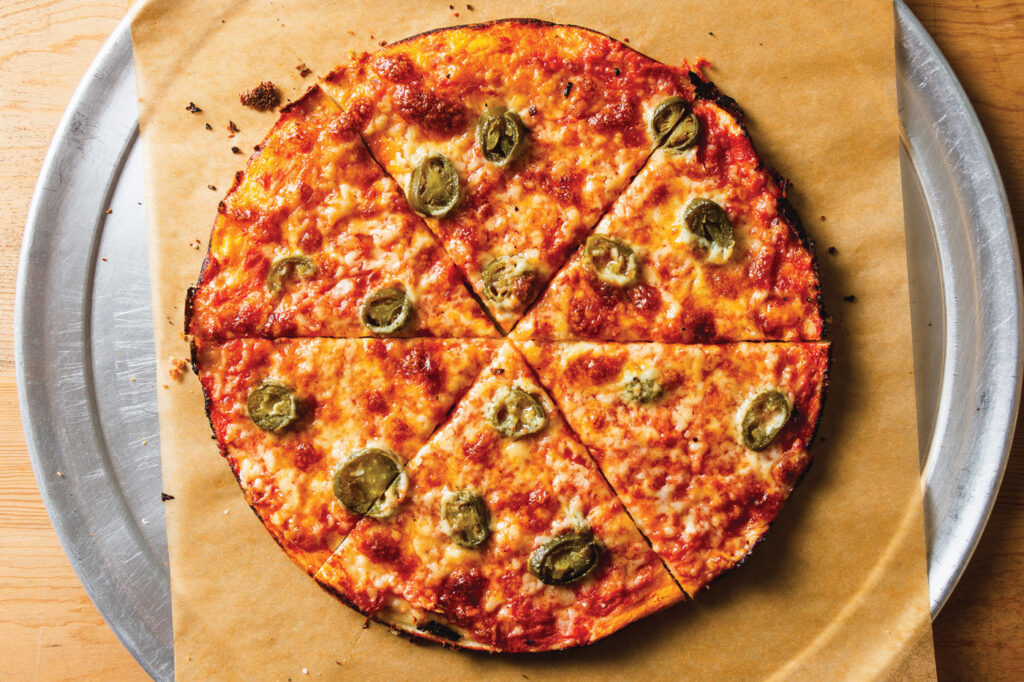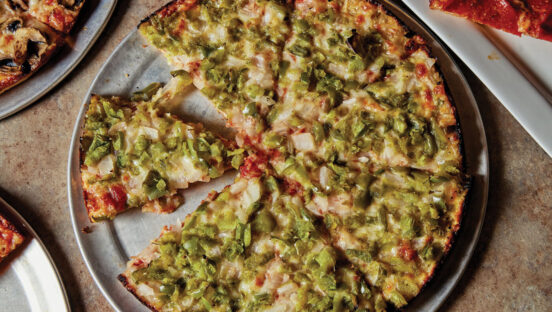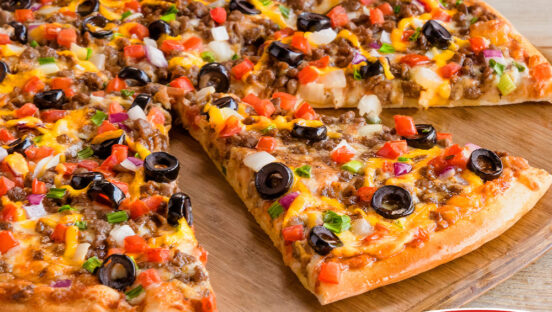By Tracy Morin
Some American pizzas were born at—and for—the bar, designed to soak up patrons’ booze as an easy-to-make, crowd-pleasing snack food. In Midwest and East Coast states, some of these iconic watering holes turned pizzerias have been neighborhood standbys for decades. But in Massachusetts, there’s a dedicated style describing this kind of pie: the South Shore Bar Pizza, named for the south-of-Boston coastal stretch where it was born.
Despite this region being relatively small in size, its pizza fans are a fervid bunch. “I’m not sure any other pizza has such a devoted fan base,” opines Andrew Janjigian, who helms Wordloaf, a bread and pizza newsletter based in Cambridge, Massachusetts. “Maybe it’s because it is from a tiny geographical area, but it’s so iconic and delicious that those who are familiar with it want to share their love of it with others far and wide.”
Brockton Born
Jeremy Jamoulis, chief operating officer of Cape Cod Cafe in Brockton, Massachusetts, notes that his pizzeria lays claim to originating this simple but delicious style. As a bar, the business opened in 1939, and when Jeremy’s grandfather, E. James “Papa” Jamoulis, assumed ownership in 1947, he added pizza to the menu. “In Brockton, an industrial city, every neighborhood had a neighborhood bar,” Jamoulis explains. “Our grandfather collaborated with friends and came up with a recipe. It’s a simple dough, but the main thing is our pans—that really distinguished bar pizza.”
At Cape Cod, dough is considered prime after a 24-hour proofing time. It’s topped with a California-tomato sauce laced with oregano and secret spices, plus a blend of cheddar cheeses (that’s right, no mozz in sight, although a few modern-day adopters may add this pizza standard to their blend). The 10” pie pans, with a 1”-high rim, are greased and, over years of use, become well-seasoned to lock in flavors. “We have some pans that are 20, 30 years old,” Jamoulis says. “We put cheddar all the way to the edge. So, even though it’s a 10” pizza, it feels bigger. Our grandfather always told us: ‘You gotta feed ’em!’”
The pizzas are cooked in deck ovens and emerge with a crispy, caramelized rim. Customers can also request sauce spread to the edge, a sub-style called a “burnt edge,” which accounts for one out of every seven pies sold. “Burnt edge is a labor of love, because you have to pay more attention to it as you’re cooking, but people love it,” Jamoulis says.
Plus, a thin crust means that it’s easy for one hungry patron to tackle alone. “I love it for loads of reasons—the crisp, oily, almost-fried crust, the tang that comes from the use of sharp cheddar, and maybe most of all the magical alchemy that happens at the edges of the pie, where the sauce, cheese and crust combine in the heat of the oven to form a crunchy, greasy, savory, just-shy-of-burned deliciousness,” Janjigian marvels. “Bar pizza is mysteriously somehow light-seeming, making it easy for one person to down a whole pie.”

The South Shore Spreads
Today, Cape Cod Cafe offers nationwide shipping of its pies—a boon to those who grew up in the area and moved away. For the past 12 years, its frozen pies have also made a splash on grocery store shelves—they’re now available throughout New England, plus New York, Pennsylvania, Ohio and West Virginia, among others. “Gaining traction in other states with our frozen pizza really helps spread the word about bar pizza,” Jamoulis says. “We’re happy to be a part of it, but we’re proud to be the originators of it, too.”
Cape Cod Café has grown to four outposts in Massachusetts (the full-service original and three smaller takeout-oriented locations), plus a facility for its frozen pies. And nowadays, of course, many more establishments are offering a South Shore Bar Pizza style to customers in the region and beyond. “It keeps you on your toes,” Jamoulis says. “You gotta get creative, come up with new ideas and new ways to execute them, and know how to make things special—which is a good thing. We’re not the only game in town anymore!”
Still, the pizza style’s growth is far beyond anything “Papa” Jamoulis likely imagined, and that’s reason enough to be thankful for the spread of this humble yet delicious pizza style. “Maybe in the past 15, 20 years, it’s been getting a lot of attention,” Jamoulis says. “I think around COVID times, it really started to take off, with people talking about it on social media. It’s been wonderful. I wish our grandfather was still here to see it. When it comes to pizza, people are as passionate as they are about their politics or religion. They want their bar pizza—they love it, and they’re loyal to it.”
Tracy Morin is PMQ’s copy editor.














